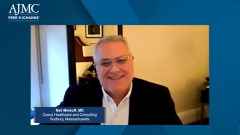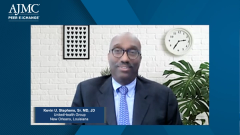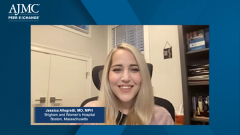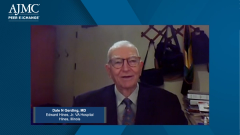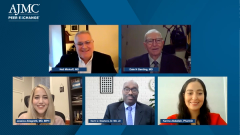
Practical Considerations for Fidaxomicin Use in Recurrent CDI
Focused discussion on the use of fidaxomicin for clostridium difficile infection, and possible barriers to the selection of this agent.
Episodes in this series

Transcript:
Neil Minkoff, MD: Let me ask you a more specific question about some of those protocols. I’ll lead with Dr Gerding on this one. We have new data, or at least a growing literature around fidaxomicin [Dificid] vs vancomycin [Vancocin]. I believe that was addressed in the IDSA [Infectious Diseases Society of America]/SHEA [Society for Healthcare Epidemiology of America] guidelines. Could you comment on that and what you think the data show?
Dale N. Gerding, MD: Sure. It’s very clear from 2 very large trials that were done for registration of fidaxomicin that it reduces recurrence from about 25% in the group treated with vancomycin down to 15% in the group treated with fidaxomicin. That’s largely the basis for the recommendation of fidaxomicin to support sustained cure. In these trials, sustained cure means cure of the infection and no recurrence within 30 days. You could extend that further, but it’s been pretty typical for antibiotic trials to use 30 days for the recurrence period. That’s the basis for the recommendation, or in the case of the IDSA guidelines, the suggestion that fidaxomicin be used rather than vancomycin. This is for first recurrence and first episode of[Clostridioides difficile].
Neil Minkoff, MD: Do you get pushback on that? When you’re trying to prescribe this, are there barriers in your way?
Dale N. Gerding, MD: Sure there are. Fidaxomicin is relatively little used. For example, the previous guidelines from the IDSA in 2017 recommended against the use of metronidazole and recommended both fidaxomicin and vancomycin. At the recent IDWeek meetings, there was an assessment of what effect this has had on the utilization of those antibiotics for treating[Clostridioides difficile] in the Medicare population. There was a 27% drop in metronidazole use and a 27% increase in vancomycin use. Fidaxomicin use, which was only in 0.8% of patients, also increased to about 1.6%. It doubled, and yet treatment with fidaxomicin was occurring in less than 4% of patients. This is basically all about acquisition cost of the drug because fidaxomicin is more expensive than vancomycin. The language of the recommendation is also tantalizing because of the “We suggest” rather than “We recommend” language that’s used.
Neil Minkoff, MD: Interesting.
Dale N. Gerding, MD: The guidelines do have an effect. But interestingly, Medicare patients even in 2018 were still being predominantly treated with metronidazole even though metronidazole was out of the guideline. But it takes time for these guidelines to be adopted. Sometimes they never get adopted very effectively. We’re in a wait and see situation right now. In the VA [Department of Veterans Affairs] system, where I work, they’re still debating how to change the formulary based on the new ACG [American College of Gastroenterology] and IDSA guidelines. Time will tell.
Neil Minkoff, MD: My follow-up question is, who’s doing most of the prescribing? Is it mostly house staff? Is it mostly primary care doctors? Is it gastroenterologists? Because it seems that would have a lot of impact on who’s following the guidelines and who’s been educated on the most up-to-date guidelines. I’ll open that up to everybody.
Dale N. Gerding, MD: For a first episode, it’s often our house staff or primary care physicians who are making the initial decision about treatment. Infectious disease specialists don’t get involved until there’s been a recurrence or maybe even more than 1 recurrence. I suspect the same is true of gastroenterology, but Dr Allegretti can tell us that.
Jessica Allegretti, MD, MPH: Yes, I agree. To the initial point about fidaxomicin, cost still remains a huge barrier. I’d certainly be using it much more if patients could get it more easily. But what ends up happening is maybe you start it on the inpatient side and then they leave with a prescription and it’s a copay of $1600, for example, and then they just can’t complete it. We’re more mindful of starting a course of it in the hospital knowing that patients aren’t going to be able to finish that course leaving the hospital. As a[Clostridioides difficile] hospital working group, we just met as well to update our internal policies in line with the guidance. But that remained a large concern.
On the outpatient side, I’m probably one of the people using fidaxomicin the most, just because I’m willing to do the prior authorizations and the necessary paperwork. Whereas somebody in a busy primary care practice might not have the resources or time to be able to do that, so prescribing something like vancomycin or, unfortunately, even metronidazole may just be easier. We see that quite a bit. I still see metronidazole being used despite the updated guidelines, probably for sake of ease.
Neil Minkoff, MD: Do you have infrastructure help available in your institution? I was a medical director there at one point, so I know a little about it. Do you have infrastructure help from either your clinic, the physician organization, or even from the Mass General Brigham Specialty Pharmacy in terms of trying to help navigate through those decisions and choke points?
Jessica Allegretti, MD, MPH: Fortunately, the answer is yes. We have several layers of pharmacy support depending. I’m also an IBD [inflammatory bowel disease] doctor, so I work with the specialty pharmacy quite closely. But for something like fidaxomicin and even bezlotoxumab [Zinplava], which I also prescribe quite a bit, oftentimes we can check ahead of time. I can work with my pharmacy colleagues and ask, “Is this going to be covered? What’s their copay going to be looking like?” So that I don’t go down the rabbit hole while the patient is suffering.
But oftentimes, if I feel very strongly about it, I do have a team of excellent pharmacists who can help me with the prior authorization process and, if there’s denials, help with appeals, because that’s often what ends up happening. We have templated letters ready to go so that we can submit them with the data and literature. Those things are needed in practice to get some of these things done. Because as you can imagine, if you get a denial and then you have to sit on the phone, schedule that peer-to-peer yourself, and write the appeal letter yourself, that’s hours out of your day that you could be seeing patients.
Neil Minkoff, MD: Yes.
Jessica Allegretti, MD, MPH: The ability to do what I do is helped substantially by the fact that I have a support team around me to help me do it.
Transcript edited for clarity.
Newsletter
Stay ahead of policy, cost, and value—subscribe to AJMC for expert insights at the intersection of clinical care and health economics.

